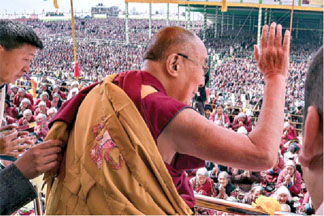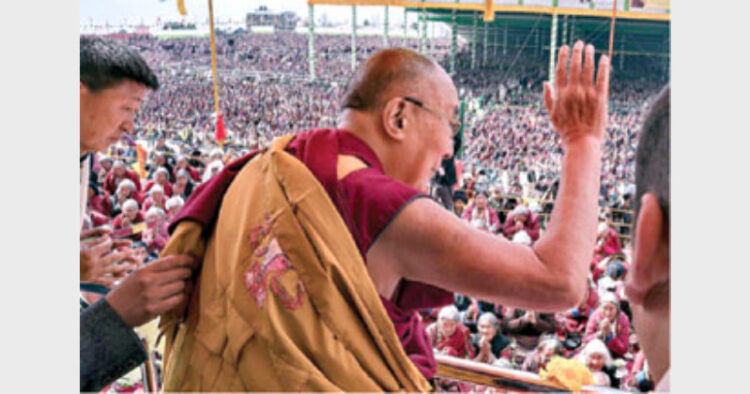 The exchange of journeys by the Indian and the Chinese monks goes back to pre-Christian era. It is this great tradition between Tibet and India that Dalai Lama has kept alive with his visit to Arunachal
The exchange of journeys by the Indian and the Chinese monks goes back to pre-Christian era. It is this great tradition between Tibet and India that Dalai Lama has kept alive with his visit to Arunachal
Dr B S Harishankar
The exchange of journeys by the Indian and the Chinese monks goes back to pre-Christian era.
The first record of it says that in 122 BC, a golden statue was gifted to the Chinese emperor, the first Buddhist statue, to mark Buddhist entry into the country, according to the Chinese Chronicle.
In 62 AD, Emperor Ming–ti dispatched an ambassador to India to collect Buddhist canons and to invite monks to China.
Kasyapa Matanga from Central India reached China, translated an important Sutra and later died at Lo-yang. Bodhidharma came to China in 470 AD and became the founder of the esoteric schools and based his philosophy on that of Nagarjuna, the patriarch of Mahayana Buddhism.
The biography of Nagarjuna was translated into Chinese by Kumarajiva around 405 AD. Kumarajiva is regarded as the first teacher of Madhyamika doctrines in China and also the expounder of Cheng-shih-tsung (Satyasiddhi) and Nieh-p-an-tsung (Nirvana) Schools. Then we have Paramartha and I-tsing who kept alive the cultural links between India and China. Fa Hien , was first of the three Chinese pilgrims, who travelled from Central Asia across the Gobi desert, crossing the Hindu Kush and and Ganga Valley to Tamralipti in Bengal.
Yuan Chwang became famous for his seventeen-year overland journey to India, during the Tang dynasty. His book Great Tang Records on the Western Regions is one of the primary sources for the study of medieval Central Asia and India.
Lamas visit to India should not be seen as a mere political event.After Santarakshita of ancient Nalanda and Padmasambhava who went to Tibet, the first great Tibetan monastery at Bsam-yas was built on the model of Udyantapuri in Bihar. Further, we should understand that the cult of Tara Mahavidya, second among Dasamahavidyas, is most prominent in Tibet, Bengal and Assam–Arunachal regions. Malinithan excavations in Arunachal have unearthed Surya and Ganesa images. At Bhishmakanagar, in Debang Valley, in Arunachal, thick brick structures enclosed by fortified ramparts have been unearthed that belong to Chutiya rulers of 11th century.
Beijing’s Peking University has now launched an ambitious programme in Sanskrit research to help translate hundreds of manuscripts containing scriptures that have been found in Tibet and other centres of Buddhism, such as Hangzhou in China’s east. The Sanskrit programme at Peking University has a long history as it was set up in the 1960s and was developed by veteran Indologist, Ji Xianlin, who translated numerous works of classical Indian literature. Classes on the ancient Sanskrit language are being resumed at the Hangzhou Buddhism Institute. Cao Yan, who teaches at Wuhan University in China, came to India on a mission to decode ancient Buddhist literature largely written in Sanskrit.
Huang Baosheng, China’s greatest living Sanskrit scholar and translator proposed to gift Prime Minister Narendra Modi Chinese translation of ancient Indian texts. Huang Yiting at the Chinese Academy of Social Sciences emphasised on Chinese interest in Indian culture Buddhism and Sanskrit.
Assam–Arunachal region served as a cultural exchange route between Tibet and China. This is evident from seals of Bhaskaravaraman of Kamarupa in Assam recovered from Nalanda.
Vikramasila Mahavihara in Bihar had considerable links with Tibet. Great masters from this University were active during the Second Transmission period. Sompura Mahavihara was another centre of learning which considerably attracted Tibet monks and was regularly visited by them. Bikrampur Vihara in Bangladesh was continuously visited by Buddhist monks from Tibet, Nepal and China.
Kibithoo in Arunachal is the eastern most and direct route into Tibet and China.The Dihang Pass situated at an elevation of 4000 ft links Arunachal with Myanmar.Arunachal is also linked by Siphu pass. Kibithoo is the easternmost and lowest direct route to Tibet and China. Dibrugarh–Tezoo-Walong–Kibithoo is the lowest crossing point into Tibet from India. It is these crucial passes and routes that China has now targeted to annex Northeast India, Myanmar and Bangladesh.
The Tawang monastery in Arunachal is one of the largest monastery of Mahayana sect in Asia. It was founded by Mera Lama Lodre Gyaltso during the 17th century, and a contemporary of the 5th Dalai Lama. It has a 28 ft high golden statue of Buddha. It contains 700 prized Buddhist scriptures of which eight volumes of Getama are its prized possession. Other monasteries of medieval and late period includes Bomdila, Rigyalling, Urgelling, Tawang Taktshang. Urgyelling monastery is the birth place of Thangyang Gyatso, the sixth Dalai Lama.The Chong or Buddhist Viharas of Namsai and Manmao are major centres of Theravada sect in Arunachal.
It is this great ancient tradition between Tibet and India that Dalai Lama has kept alive with his visit to Arunachal. In fact, Communism has an inborn animosity to Buddhism. This is evident from looting of Buddhist monasteries and temples in Russia and China by the Communist regimes.
The Guardian reported that a Buddhist Institute in Tibet’s autonomous region, Chinese officials made students denounce the Dalai Lama and swear allegiance to the Communist party. If China has to understand its past ties with India it should do some introspection.
(The writer is a Kochi-based research scholar)














Comments